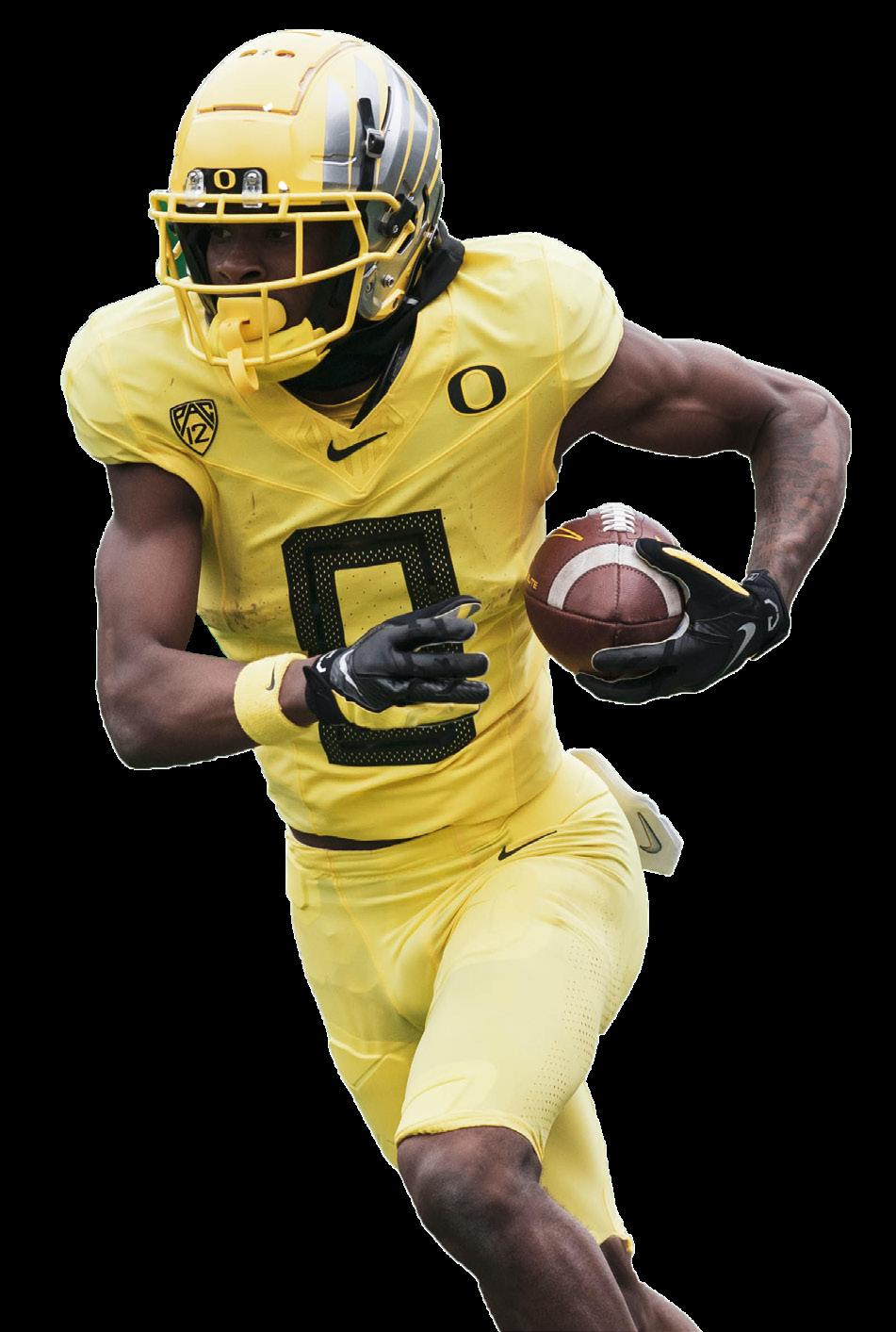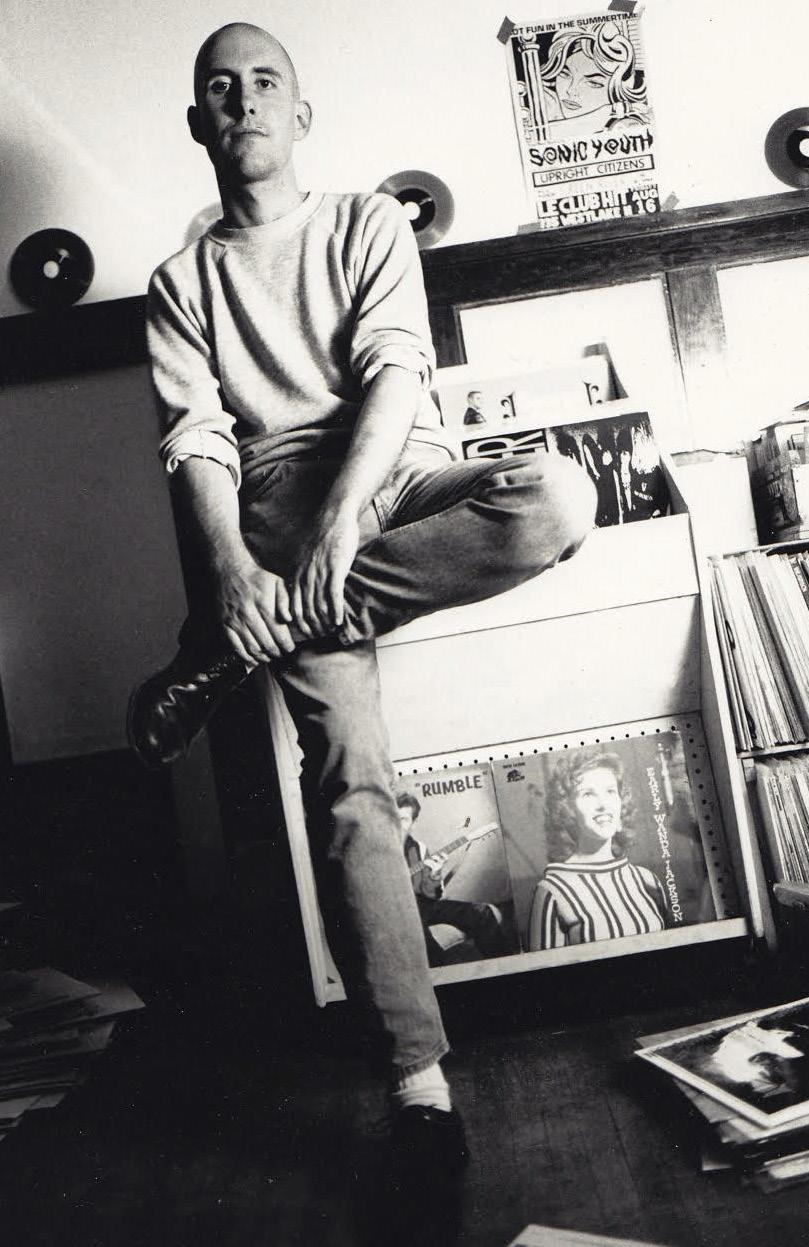
8 minute read
SPORTS
5TAKEAWAYS
Ducks green team successfully intercept a ball during an offensive play by yellow. Oregon Ducks football host annual spring game at Autzen Stadium in Eugene, Ore., on May 1, 2021. (Maddie Stellingwerf/Emerald)
FROM THE DUCKS SPRING FOOTBALL GAME
BY AARON HEISEN • TWITTER @AARON_HEISEN
The Oregon Ducks football team made its return to Autzen Stadium for the spring game on Saturday, May 1. After 15 practices it was time for the players to show out on national television. The game was exciting and gave Ducks fans a glimpse of what to expect for this upcoming season. 1. Jay Butterfield looked
confident as the second-string Quarterback
Second-year freshman quarterback Jay Butterfield earned the spot as No. 2 quarterback in the game. He took a lead in the three-way race between Butterfield, Ty Thompson and Robby Ashford that flooded headlines during spring camp.
On Saturday, Butterfield made a statement performance. On his first throw of the afternoon, he found freshman Troy Franklin streaking down the right side of the field for a 41-yard completion. Butterfield capped off the drive with an 11-yard touchdown pass to Kris Hutson five plays later.
“I love Butterfield,” Hutson said. “All our quarterbacks can sling it but his arm is terrific.”
The quarterback competition will continue into the fall, and senior Anthony Brown is still the likely frontrunner, but it seems that Butterfield may be gaining an upper-hand as the backup. He completed six of nine pass attempts for 118 yards and a touchdown. 2. Justin Flowe didn’t miss a
beat in his return
After missing the 2020 season due to a torn meniscus, Justin Flowe was in danger of plummeting down the depth chart. Saturday, Flowe showed up early and often, recording four tackles and a sack.
“It’s great to see [Flowe] out there. He’s a freak,” Spencer Webb said. “He’s more motivated than ever, and he’s gonna make some plays for us and I can’t wait to see that.”
Defensive coordinator Tim DeRuyter used Flowe in three and four linebacker sets.
The freshman displayed range as a pass-rusher, run stuffer and coverage linebacker primarily out of the strong side linebacker position.
He came up and stuffed C.J. Verdell after using a swim move to dismantle Alex Forsythe, adding his second tackle for loss of the ball game.
His performance speaks volumes to the time he put into recovering from his injury and improving during spring camp. Flowe will likely be integral in the middle for the Ducks, bringing another physical presence alongside Noah Sewell. 3. Defensive schemes tailored
to versatile personnel groupings
Defensive coordinator Tim DeRuyter used a 3-4 defensive scheme with Cal, but he has talked about retooling his scheme because of the versatility of Oregon’s defensive personnel.
“The defense is definitely different,” Jackson LaDuke said. “We play faster and [coach DeRuyter] has simplified things but we’re still adapting to our new roles.”
On Saturday, the Ducks’ first-team defense primarily rushed two down lineman and two edge rushers, while the three linebackers dropped into coverage.
Additionally, DeRuyter used freshman cornerback Donte Manning in a multitude of positions. Manning lined up in man on the outside and came inside on third downs to man the nickel back position. 4. Walk-on Aaron Smith
impressed in high-volume game
The Oregon Ducks’ backfield, led by juniors Travis Dye and Verdell, is one of the nation’s best and most experienced. However, walk-on freshman Aaron Smith made the best of his high-volume opportunity on Saturday. Smith carried the ball 15 times, tallying 56 yards and a touchdown.
“Aaron’s been a blessing to the running back room,” Verdell said. “He’s picked up the offense right away and pays attention to detail. I was very proud of what he did today.”
Smith scored a four-yard touchdown after an impressive 70-yard drive to start the second quarter. On that drive alone, he carried the ball five times for 29 yards.
The freshman from San Jose, California, took snaps behind Anthony Brown and Oregon’s starters. While Smith didn’t receive a carry in his three snaps with the starters, it shows that head coach Mario Cristobal has instilled trust in him and Smith might have the chance to come in relief of the starting running backs this season. 5. Henry Katleman adds to
impressive kicking resume
After consecutive years of struggles in the kicking game, things are trending upwards for the Ducks. Henry Katleman boomed a 52-yarder through the uprights at the end of the first half on Saturday, building off his impressive late-season surge in 2020. He also knocked in a 37yard field goal earlier in the day.
Katleman and Camden Lewis took turns on kickoff duty. Each kicked one out of the back of the endzone for touchbacks, a potentially important sign for a Ducks team that regressed in both punt return and kick return defense last season.
Teams live and die by the efficiency of their kicking game and today Katleman showed that the Ducks can rely on his steady leg to be a complimentary part of their offense. The atmosphere at the Ducks’ Saturday game was competitive as the offense and defense went head-to-head, culminating with Robby Ashford diving for the pylon on a two-point conversion on the final play of the game.

Ducks wide receiver Dont'e Thornton Jr. (0) rushes the ball to the goal line. Oregon Ducks football host annual spring game at Autzen Stadium in Eugene, Ore., on May 1, 2021. (Maddie Stellingwerf/ Emerald)
BRUCE PAVITT
AND THE BIRTH OF GRUNGE
Seattle's music man shares his point of view on the Pacific Northwest scene, the start of Sub Pop and his upcoming project, Modify.
BY MALENA SAADEH

(Courtesy of Bruce Pavitt) (Courtesy of Bruce Pavitt)

Even 30 years past its heyday, the noise up north stays synonymous with a stripped sound that translates on record just as it was made — raw, unpolished and packed full of punch. This infectious energy that became known as grunge first exploded in Seattle and sent out major shockwaves with its initial blast. But, believe it or not, this wasn’t always the case. It took Bruce Pavitt, a music fanatic from Chicago with an insatiable appetite for the underground music scene, to put the Pacific Northwest on the map. Building the record label Sub Pop from the ground up and taking his seat at the table as the guru of grunge, Pavitt’s mark on music knows no bounds both in the past and in the present.
Responsible for kickstarting the careers of greats like Mudhoney, Soundgarden and Nirvana, Sub Pop’s influence on the whole of pop culture is immeasurable. Before the Seattle label defined grunge and grunge defined not just a decade, but a lifestyle, the Northwest scene in the early eighties was wide open and its potential was ready to be pounced upon.
“People really had no idea what was going on in Seattle at that time, so we were able to create an almost mythical status for the city,” Pavitt said about the roots of Sub Pop.
This whole journey started when Pavitt was a student at Evergreen State College, a liberal arts school in Washington, in 1979 and found himself a job as a DJ for local radio station KAOS. He had discovered his love for all things local back in Chicago, while shopping for vinyl at Wax Trax, and became hooked when he saw the DIY selection the Washington radio station had to offer.
“It became apparent to me that some of the most interesting music in the country was coming out on indie labels,” Pavitt said. “I realized that every city in the country had an art scene and that's where all the creative juice was going to be found.”
This realization led Pavitt to put together a zine called Subterranean Pop where he focused on fronting new wave, punk and experimental artists that weren’t yet in the public eye. In a time when being in the business meant being in a big city, local acts constantly flew under the radar of major labels, itching to be discovered, Pavitt said. With his finger on the pulse of the up and coming, Pavitt recognized the aesthetic similarities in music making across the board, and intended to tie like-minded musicians together.
The desire to connect music lovers to the music that they love continues to push Pavitt forward in the present, and he has been evolving his own work to appeal to the ever changing nature of the business. Grunge ruled the world for a point in time — hell, its existence singlehandedly derailed the Sunset Strip — but keeping ahead of the curb allowed Pavitt to spot trends as they appear.
The Northwest, no doubt, has succumbed to a more indie energy since the end of grunge’s golden years, and, although what's hot now may have changed, the roots stem from the same place.
“Indie culture is always going to primarily be resourceful. It’s going to work with smaller budgets, and it’s going to work creatively within those budgets,” Pavitt said. “That can take on any number of sounds.”
Bedroom pop acts like Rex Orange County and Clairo dominate the radio nowadays, Pavitt said, and while the theme might be a bit softer and more introspective, the foundational qualities are DIY through and through. Pavitt was always one to take a stab at a homespun sound, and that’s been on display since Nirvana’s 1989 Subpop debut “Bleach.” This album in particular was brought to life by producer Jack Endino in fewer than 30 hours for just over $600 and serves as a direct comparison to the climate of indie music making today. Now that anyone can master a recording in minutes with the technology available outside of a studio, the possibilities in music seem to be endless. Pavitt recognizes this phenomenon and is hoping to further pull out the producer in us all with his new project, Modify.
Working in collaboration with Sub Pop, Pavitt hints that Modify will change the way people see the limitations on music making. Though Modify is still in the works and there isn’t much out on it yet, one thing for sure is that Bruce Pavitt stays on the edge of innovation and continues to serve listeners the next step in music.




